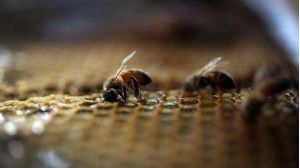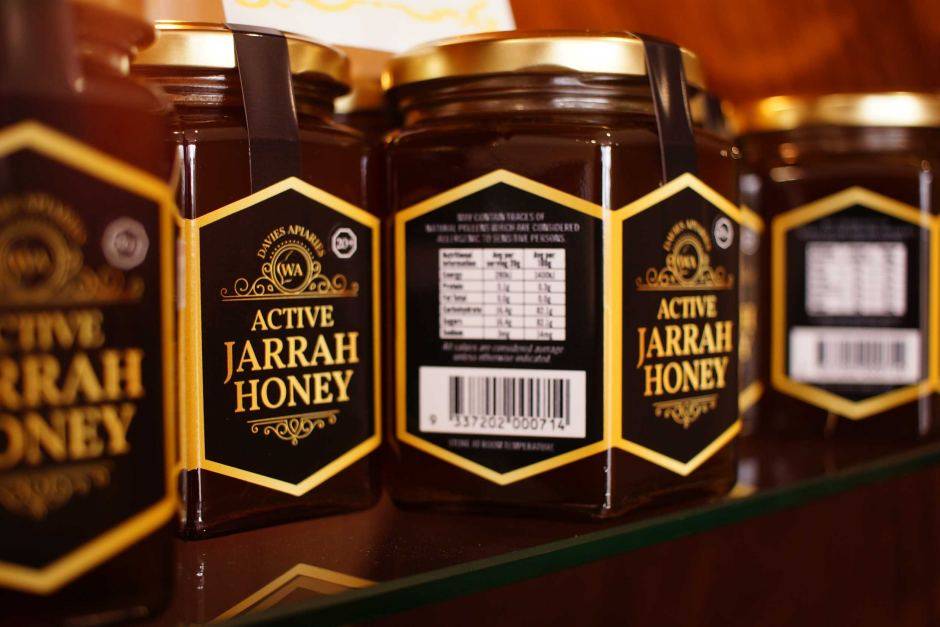
PHOTO: In high demand, Jarrah and Marri honey fetches a high price due to its medicinal properties (ABC News: Robert Koenig-Luck)
Western Australia is experiencing a new gold rush, but it has nothing to do with precious metals.
It's liquid gold — honey sourced from the state's unique jarrah and other forests, rich in antimicrobial and other health giving properties.
Farm gate prices have increased tenfold in the last decade and the strongest "medi-honeys" are now selling for as much as $100 a kilogram in China.
Independent testing of jarrah and marri honey in New Zealand in 2016 found that it had stronger antimicrobial properties than the much prized manuka honey.
Jarrah and marri honey samples were submitted for a phenol equivalence assay, which compared resistance against Staphylococcus aureus, otherwise known as golden staph.

PHOTO: Some samples of Jarrah honey have 30 per cent more antimicrobial activity. (ABC News: Robert Koenig-Luck)
The results confirm work being done by WA's government laboratory, the ChemCentre which has also found the forest honeys are anti-inflammatory, high in antioxidants and are good for human gut health.
The ChemCentre's principal food scientist Ken Dods, said some of the WA samples had 30 per cent higher activity than manuka.
"Jarrah and Marri honey, because of the nature of the activity that we have — which is a peroxide based activity — actually has quite a broad spectrum antimicrobial activity," Mr Dods said.
Rather than talking about one being better than another, what we would like to see in a therapeutic manner is in different situations you would use a different honey depending on what therapeutic basis is required.
"Diversity is a very good thing because … what we end up with is stronger therapeutic outcomes."

PHOTO: Busy as always making honey rich in antimicrobial properties (ABC News: Robert Koenig-Luck)
Mr Dods is managing a $3.1 million research project on WA's bioactive honeys.
He said the aim was to build science-based foundations for the industry including how to measure the range of bioactivity in the forest honeys.
"What I'm doing is helping them produce something more consistently and more clearly identifying for them the key attributes of those honeys that they can then use in their marketing," Mr Dods said.
"The ChemCentre is providing the international certification that gives the credibility that enables them to get a really good price for their product."
Investors buzzing as popularity grows
Prices are already surging on the back of unprecedented demand for WA's mono-floral honey, which is selling for about $30 a kilogram at the farm gate.
According to chairman of the WA Bee Industry Council, Colin Fleay, five new extraction and packing plants have been built recently to take advantage of export opportunities, changing what has been a largely cottage-based industry selling blended honey.

PHOTO: No gloves needed for chairman of the Bee Industry Council of Western Australia, Colin Fleay. (ABC News: Robert Koenig-Luck)
"They [investors] are all coming in now, as soon as people realise the worth of the product because it sells itself," Mr Fleay said.
"If you've got a good product with major health benefits people are going to want it and if there's a premium on it compared to the normal price of honey, anywhere there's money people will come."
The state's biggest producer is Capilano, which bought into WA honey industry in 2013 and now includes media baron Kerry Stokes as a 20 per cent shareholder.

PHOTO: Manuka honey is available in supermarkets and shoppers pay a premium price. (ABC Rural: Brian Hurst )
Managing director Michael Bellman said the company wanted to triple its production of jarrah and other forest honeys but was mindful of the market fraud which had beset New Zealand's manuka industry.
He said WA producers were working together to certify international distributors and create consistent industry standards.
"It's so important we maintain a presence in Western Australia, we keep packing in WA. We don't want to send bulk honey overseas, which can be adulterated like the New Zealand stuff has happened," Mr Bellman said.
"It can end up being 10 tonne on the ground becoming 100 tonne because they put something else in it, so we want to make sure that whole custodian supply chain is maintained."
Tackling issues plaguing the industry
Traceability and chain of custody models will be key areas of research for the newly formed Honey Bee Products Collaborative Research Centre (CRC), which was opened in Perth at the end of last year.
With a budget of about $7 million the CRC will have up to 26 research projects running at once in areas such as bee health and nutrition, hive site management, plantations and professional certification.
"What it does is connect us with everything that's happening internationally … so we can translate immediately something we see out there and bring it into Australia and incorporate it into what we're doing," said the CRC's new chief executive Liz Barbour.
Dr Barbour said the CRC may join an international research effort to breed bees resistant to the varroa mite parasite, which had devastated colonies around the world.

PHOTO: Varroa mites on a honey bee pupae. A virus the mites carry is damaging to bees (Supplied: Queensland Department of Agriculture, Fisheries and Forestry)
Australia was one of the only places where the parasite had not taken hold and the CRC could use cutting edge proteomics to study varroa resistant bees discovered in Brazil and Africa.
Dr Barbour said researchers could investigate resistance without exposing any bees to the varroa mite.
"Normally if you want to breed up resistance in a population you have to expose it to that disease," she said.
"The new way of doing that scientifically is actually to look at … the protein profile of a bee that is resistant, and instead of us actually exposing the bee to the disease we look for those protein profiles and then we start breeding bees up.
"And of course the big advantage is we have one of the oldest breeding programs here in Western Australia."

PHOTO: The queen bee is essential to the entire operation. (ABC News: Robert Koenig-Luck)
WA has what is thought to be the world's oldest continuous queen bee breeding program on Rottnest Island which could be crucial if Australia has to survive a future incursion of varroa mite.
The program began in 1980 when the Department of Agriculture started 20 new breeding lines because quarantine restrictions meant local bee keepers could no longer import queens from the eastern states.
The Better Bee program is now a collaboration between eight commercial bee keepers who send drones and queens to Rottnest every year to help maintain the genetic health and diversity of their hives.

PHOTO: Rottnest Island lies 16km off the coast of Perth and it's the perfect site for breeding bees. (Supplied: Rottnest Island Authority)
Rottnest is 16 kilometres from the mainland, which is too far for bees to fly so the isolation guarantees the genetic integrity of the program.
The queens bred on the holiday island are famed for their calm temperament and ability to produce bees which yield up to double the global average of honey per hive.
According to Mr Fleay, who is one of the Rottnest breeders, the island could be crucial for the survival of the industry if there is a verroa mite incursion.
"You could go and set up a permanent breeding program over there and supply the rest of the mainland and you could trial verroa resistant stock and things like that, so the Rottnest Island project is an integral part of the whole survival mechanism we've got in plan," Mr Fleay said.
Watch the full story on Landline Sunday, February 11, at the new time of 12.30pm.
http://www.abc.net.au/news/2018-02-03/wa-jarrah-marri-honey-gives-manuka-a-run-for-its-money/9211874




